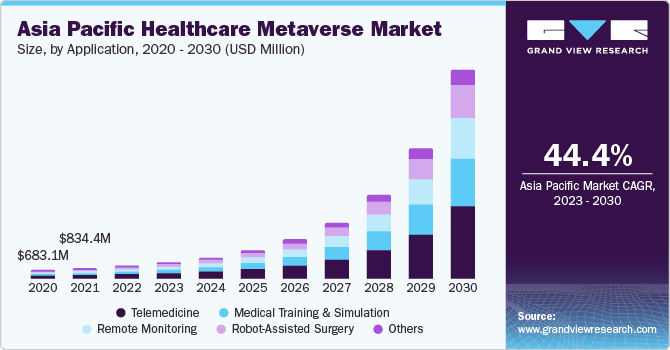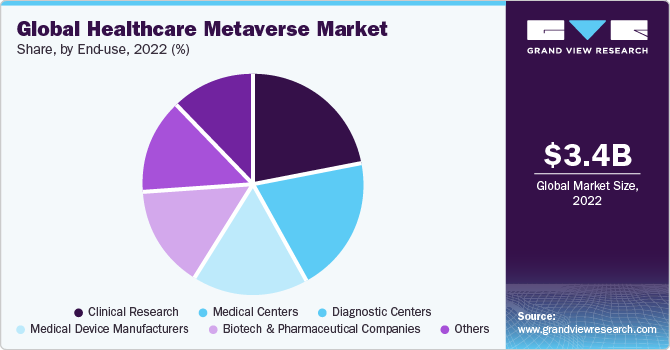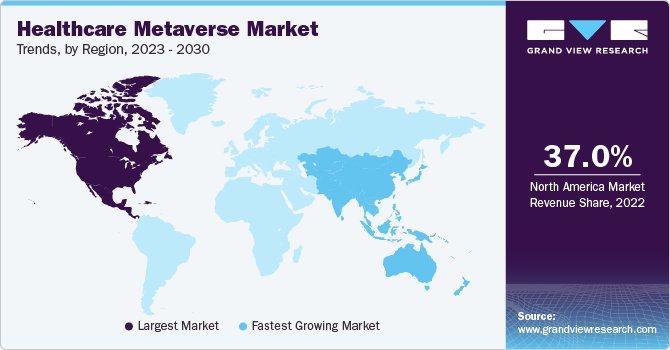- Home
- »
- Next Generation Technologies
- »
-
Healthcare Metaverse Market Size And Share Report, 2030GVR Report cover
![Healthcare Metaverse Market Size, Share & Trends Report]()
Healthcare Metaverse Market Size, Share & Trends Analysis Report By Component (Hardware, Software), By Technology (AR & VR, Artificial Intelligence), By Application, By End-use, By Region, And Segment Forecasts, 2023 - 2030
- Report ID: GVR-4-68040-152-0
- Number of Report Pages: 100
- Format: PDF, Horizon Databook
- Historical Range: 2017 - 2021
- Forecast Period: 2023 - 2030
- Industry: Technology
Healthcare Metaverse Market Size & Trends
The global healthcare metaverse market size was estimated at USD 3.36 billion in 2022 and is expected to expand at a compound annual growth rate (CAGR) of 42.6% from 2023 to 2030. Rapid developments in augmented reality (AR), virtual reality (VR), and artificial intelligence (AI) have substantially transformed the healthcare sector. These technologies have enabled the creation of immersive and realistic healthcare experiences, thus revolutionizing patient care, medical training, and diagnostics. Medical simulations in virtual environments enable healthcare professionals to practice and refine their skills with lifelike scenarios, ultimately improving the quality of care. Telemedicine and remote monitoring in the metaverse provide convenient and accessible healthcare services, especially during the COVID-19 pandemic, ensuring patients receive timely and safe medical attention.

Metaverse technologies are instrumental in expanding healthcare accessibility, particularly in rural or underserved regions. They empower patients to access healthcare services remotely, eliminating the need for physical presence. Through these technologies, individuals can receive consultations, diagnoses, and even treatment, bridging geographical gaps and ensuring that healthcare services are more readily available to those who might otherwise face barriers to care. This improved accessibility has the potential to enhance overall healthcare outcomes and address healthcare disparities in underserved areas. For instance, InTouch Health is a U.S.-based telehealth company that uses virtual presence and communication technologies to connect patients and healthcare professionals. Their platform enables remote consultations and the delivery of care services, improving healthcare access.
Virtual healthcare solutions have emerged as a cost-effective and transformative force in the healthcare industry. They alleviate the financial burden associated with physical healthcare infrastructure, patient travel, and in-person appointments, benefiting both healthcare providers and patients. This shift not only optimizes healthcare delivery but also democratizes access, making quality care more accessible to individuals regardless of their geographic location. Moreover, the integration of artificial intelligence and data analytics within these virtual environments enhances the precision of medical diagnostics and treatment recommendations. The ability to harness vast datasets and employ AI-driven algorithms enables healthcare providers to offer highly accurate and personalized care.
Component Insights
The software segment dominated the market with a revenue share of over 45.2% in 2022. The software segment dominates the market because it serves as the foundation for versatile and interactive virtual healthcare applications. It enables real-time communication, data management, and AI integration, providing the essential tools for accurate diagnostics, personalized care, and cost-effective healthcare solutions. Software's inherent flexibility and ease of customization enable healthcare providers to customize virtual healthcare experiences to individual patient needs, ultimately driving its dominance in the market.
The services segment is also witnessing substantial growth due to its indispensable role in ensuring the successful adoption of metaverse technologies within healthcare organizations. Service providers offer crucial customization and implementation services, customizing virtual healthcare applications to meet the unique needs of providers and patients. They facilitate essential training and education for healthcare professionals, ensuring proficient use of these technologies. Moreover, service providers offer technical support, data management, and security services to maintain the operational integrity and regulatory compliance of virtual healthcare environments. They help in interoperability, strategic consultation, and compliance with healthcare regulations, contributing to the integration of metaverse technologies into healthcare systems.
Technology Insights
The AR and VR segment dominated the market with a revenue share of 38.1% in 2022. The AR (Augmented Reality) and VR (Virtual Reality) segment is growing in the market due to its transformative impact on medical training, patient care, and diagnostics. These technologies offer immersive training experiences, enabling healthcare professionals to enhance patient outcomes. In telemedicine, AR and VR create lifelike remote consultations, fostering a sense of presence and engagement. They also contribute greatly to pain management, rehabilitation, and physical therapy, encouraging patients to stick to their treatment plans.
The artificial intelligence (AI) segment is expected to witness significant growth in the market in the coming years due to its transformative capabilities. The data-driven insights offered by this technology are critical in improving healthcare through the analysis of vast amounts of patient data, leading to more accurate diagnoses, personalized treatment plans, and early disease detection. Its role in enhancing telemedicine experiences, advancing medical imaging, streamlining drug discovery, and even simplifying administrative tasks is pivotal for the healthcare industry. AI's continual evolution ensures it will remain at the forefront of healthcare metaverse applications, offering smarter, more efficient, and patient-centric solutions while also contributing to regulatory compliance and the future of personalized medicine.
Application Insights
The telemedicine segment dominated the market with a revenue share of 31.4% in 2022. The metaverse's immersive technology enhances the accessibility of remote healthcare, enabling patients to receive consultations, diagnosis, and treatment from the comfort of their homes. The rapid adoption of telemedicine, accelerated by the COVID-19 pandemic, has changed healthcare delivery, making it a vital application within the metaverse. Moreover, continuous monitoring, global consultations, virtual clinics, and mental health support all contribute to telemedicine's prominence in the metaverse. At the same time, advanced data security ensures the privacy and confidentiality of patient information, further boosting its appeal.
The medical training and simulation segment is expected to grow at a CAGR over the forecast period due to its exceptional capacity to provide healthcare professionals with immersive and realistic training environments. Metaverse applications offer lifelike simulations of medical procedures and patient care scenarios, enabling safe and hands-on skill development while reducing the risks associated with real-world training. This approach not only fosters continuous learning and skill enhancement but also promotes global collaboration, standardizes medical education, and leverages adaptive learning, making it an efficient and cost-effective solution. Furthermore, the metaverse's remote accessibility extends medical training to underserved areas, ensuring a well-prepared healthcare workforce and addressing evolving healthcare needs.
End-use Insights
The clinical research segment dominated the market with a revenue share of 22.0% in 2022. Clinical research takes center stage in the market's end-use segment, primarily due to the metaverse's ability to revolutionize the way research is conducted. The data-intensive nature of clinical research finds an ideal match in the metaverse's capacity to handle, visualize, and simulate complex datasets. Researchers can conduct immersive trials, collaborate globally, monitor data in real-time, and engage with a broader and more diverse subject pool, all while significantly reducing the costs associated with traditional trials. Moreover, the metaverse offers advanced data security and patient monitoring, making it a compelling choice for research organizations aiming to streamline research processes, increase efficiency, and enhance the quality of research outcomes.

The metaverse's transformative capabilities enable medical centers to redefine patient care, offering more engaging and patient-centered experiences, ultimately leading to enhanced healthcare outcomes. With the metaverse, medical centers can extend their reach through remote consultations and telemedicine, providing medical expertise and services to patients, regardless of their geographic location. Furthermore, these centers can utilize metaverse technologies for training and education, offering immersive simulations and educational modules that improve the skills and knowledge of healthcare professionals, medical students, and staff. This approach, combining advanced patient care and education, positions medical centers at the forefront of the metaverse's impact on healthcare.
Regional Insights
North America dominated the market with a revenue share of over 37.0% in 2022. The region's leadership in technology and innovation ensures a constant stream of advanced healthcare metaverse solutions. The presence of a robust tech ecosystem, collaborative efforts between educational and research institutions, and a supportive policy environment all facilitate the development and integration of Healthcare Metaverse applications. Furthermore, the availability of substantial venture capital and investment, coupled with the global influence of North American companies, propels the rapid adoption of Healthcare Metaverse solutions. The varied healthcare environment and the digitally proficient populace in North America provide fertile soil for the growth of virtual healthcare services, ultimately defining the metaverse's place in the future of healthcare.

The Asia-Pacific region is poised to advance at the fastest CAGR of 44.4% through 2030. The region is witnessing strong growth in the market, aided by the rising population, growing access to advanced technologies, and the increasing demand for innovative healthcare solutions. Additionally, the region's diverse healthcare requirements, along with a proactive approach to technology adoption, are harboring the adoption and development of metaverse applications in the healthcare space. This dynamic environment, combined with investments in research and development, positions the Asia Pacific as a promising hub for metaverse-driven healthcare innovations, promising improved healthcare accessibility and outcomes.
Key Companies & Market Share Insights
The market is marked by intense competition, with a small number of global competitors holding substantial market share. The primary emphasis is on creating innovative products and fostering collaboration among the key industry participants. For instance, In July 2023, CoxHealth, a U.S.-based healthcare provider, collaborated with Philips, a health technology company, to implement a virtual care solution throughout its hospital network. The initiative aims to enhance patient care, outcomes, and staff experience beyond traditional eICU programs, utilizing Philips' eCareManager and Capsule Surveillance software.
In November 2022, HealthStream, a U.S. healthcare workforce solutions provider, teamed up with CAE Healthcare, a medical simulation solution provider. This partnership enables healthcare organizations using HealthStream's American Red Cross Resuscitation Suite to complete certification with hStream-certified CAE Healthcare manikins. Utilizing the hStream platform, this collaboration offers flexibility in choosing manikins for resuscitation training, introducing a previously unavailable choice.
Key Healthcare Metaverse Companies:
- Brainlab
- Medtronic PLC
- Meta Platforms Inc
- Microsoft Corporation
- Nvidia Corporation
- Roblox Corporation
- Sesame, Inc.
- Siemens Healthineers
- Veyond Metaverse
- Zimmer Biomet Holdings, Inc.
Healthcare Metaverse Market Report Scope
Report Attribute
Details
Market size value in 2023
USD 4.23 billion
Revenue forecast in 2030
USD 50.84 billion
Growth rate
CAGR of 42.6% from 2023 to 2030
Base year for estimation
2022
Historical data
2017 - 2021
Forecast period
2023 - 2030
Report updated
November 2023
Quantitative units
Revenue in USD Million/billion, and CAGR from 2023 to 2030
Report Coverage
Revenue forecast, company ranking, competitive landscape, growth factors, trends
Segments Covered
Component, technology, application, end-use, region
Regional scope
North America; Europe; Asia Pacific; Latin America; MEA
Country scope
U.S.; Canada; UK; Germany; France; China; India; Japan; South Korea; Australia; Brazil; Mexico; KSA; UAE; South Africa
Key companies profiled
Brainlab; Medtronic PLC; Meta Platforms Inc; Microsoft Corporation; Nvidia Corporation; Roblox Corporation; Sesame, Inc.; Siemens Healthineers; Veyond Metaverse; Zimmer Biomet Holdings, Inc.
Customization scope
Free report customization (equivalent up to 8 analysts’ working days) with purchase. Addition or alteration to country, regional, and segment scope.
Pricing and purchase options
Avail customized purchase options to meet your exact research needs. Explore purchase options
Global Healthcare Metaverse Market Report Segmentation
This report forecasts revenue growth at global, regional, and country levels and provides an analysis of the latest industry trends in each of the sub-segments from 2017 to 2030. For this study, Grand View Research has segmented the global healthcare metaverse market report based on component, technology, application, end-use, and region:
-
Component Outlook (Revenue, USD Million, 2017 - 2030)
-
Hardware
-
Software
-
Services
-
-
Technology Outlook (Revenue, USD Million, 2017 - 2030)
-
AR and VR
-
IoT and Wearable Health Devices
-
Artificial Intelligence
-
Others
-
-
Application Outlook (Revenue, USD Million, 2017 - 2030)
-
Telemedicine
-
Medical Training and Simulation
-
Remote Monitoring
-
Robot-Assisted Surgery
-
Others
-
-
End-use Outlook (Revenue, USD Million, 2017 - 2030)
-
Clinical Research
-
Medical Centers
-
Diagnostic Centers
-
Medical Device Manufacturers
-
Biotech and Pharmaceutical Companies
-
Others
-
-
Regional Outlook (Revenue, USD Million, 2017 - 2030)
-
North America
-
U.S.
-
Canada
-
-
Europe
-
UK
-
Germany
-
France
-
-
Asia Pacific
-
China
-
India
-
Japan
-
South Korea
-
Australia
-
-
Latin America
-
Brazil
-
Mexico
-
-
Middle East and Africa
-
KSA
-
UAE
-
South Africa
-
-
Frequently Asked Questions About This Report
b. The global healthcare metaverse market size was estimated at USD 3.36 billion in 2022 and is expected to reach USD 4.23 billion in 2023.
b. The global healthcare metaverse market is expected to grow at a compound annual growth rate of 42.6% from 2023 to 2030 to reach USD 50.84 billion by 2030.
b. North America dominated the healthcare metaverse market with a share of 37.0% in 2022. This is attributable to the region's leadership in technology and innovation ensures a constant stream of advanced Healthcare Metaverse solutions. The presence of a robust tech ecosystem, collaborative efforts between educational and research institutions, and a supportive policy environment all facilitate the development and integration of Healthcare Metaverse applications.
b. Some key players operating in the healthcare metaverse market include Brainlab, Medtronic PLC, Meta Platforms Inc, Microsoft Corporation, Nvidia Corporation, Roblox Corporation, Sesame, Inc., Siemens Healthineers, Veyond Metaverse, Zimmer Biomet Holdings, Inc.
b. Key factors that are driving the market growth include rapid advancements in virtual reality (VR), augmented reality (AR), and artificial intelligence (AI) .
Share this report with your colleague or friend.
![gvr icn]()
NEED A CUSTOM REPORT?
We can customize every report - free of charge - including purchasing stand-alone sections or country-level reports, as well as offer affordable discounts for start-ups & universities. Contact us now
![Certified Icon]()
We are GDPR and CCPA compliant! Your transaction & personal information is safe and secure. For more details, please read our privacy policy.
We are committed towards customer satisfaction, and quality service.
"The quality of research they have done for us has been excellent."





